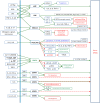Understanding chronic inflammation: couplings between cytokines, ROS, NO, Cai 2+, HIF-1α, Nrf2 and autophagy
- PMID: 40264757
- PMCID: PMC12012389
- DOI: 10.3389/fimmu.2025.1558263
Understanding chronic inflammation: couplings between cytokines, ROS, NO, Cai 2+, HIF-1α, Nrf2 and autophagy
Abstract
Chronic inflammation is an important component of many diseases, including autoimmune diseases, intracellular infections, dysbiosis and degenerative diseases. An important element of this state is the mainly positive feedback between inflammatory cytokines, reactive oxygen species (ROS), nitric oxide (NO), increased intracellular calcium, hypoxia-inducible factor 1-alpha (HIF-1α) stabilisation and mitochondrial oxidative stress, which, under normal conditions, enhance the response against pathogens. Autophagy and the nuclear factor erythroid 2-related factor 2 (Nrf2)-mediated antioxidant response are mainly negatively coupled with the above-mentioned elements to maintain the defence response at a level appropriate to the severity of the infection. The current review is the first attempt to build a multidimensional model of cellular self-regulation of chronic inflammation. It describes the feedbacks involved in the inflammatory response and explains the possible pathways by which inflammation becomes chronic. The multiplicity of positive feedbacks suggests that symptomatic treatment of chronic inflammation should focus on inhibiting multiple positive feedbacks to effectively suppress all dysregulated elements including inflammation, oxidative stress, calcium stress, mito-stress and other metabolic disturbances.
Keywords: HIF-1α; NF-κB; autophagy; calcium flux; cytokines; iNOS; inflammation; nitric oxide.
Copyright © 2025 Michalak and Michalak.
Conflict of interest statement
The authors declare that the research was conducted in the absence of any commercial or financial relationships that could be construed as a potential conflict of interest.
Figures






Similar articles
-
Chronic nitric oxide deprivation induces an adaptive antioxidant status in human endothelial cells.Cell Signal. 2013 Nov;25(11):2290-7. doi: 10.1016/j.cellsig.2013.07.026. Epub 2013 Aug 1. Cell Signal. 2013. PMID: 23917205
-
L-2-Oxothiazolidine-4-carboxylic acid or α-lipoic acid attenuates airway remodeling: involvement of nuclear factor-κB (NF-κB), nuclear factor erythroid 2p45-related factor-2 (Nrf2), and hypoxia-inducible factor (HIF).Int J Mol Sci. 2012;13(7):7915-7937. doi: 10.3390/ijms13077915. Epub 2012 Jun 25. Int J Mol Sci. 2012. PMID: 22942681 Free PMC article.
-
Impairment of HIF-1α-mediated metabolic adaption by NRF2-silencing in breast cancer cells.Redox Biol. 2019 Jun;24:101210. doi: 10.1016/j.redox.2019.101210. Epub 2019 May 2. Redox Biol. 2019. PMID: 31078780 Free PMC article.
-
Chronic and Cycling Hypoxia: Drivers of Cancer Chronic Inflammation through HIF-1 and NF-κB Activation: A Review of the Molecular Mechanisms.Int J Mol Sci. 2021 Oct 2;22(19):10701. doi: 10.3390/ijms221910701. Int J Mol Sci. 2021. PMID: 34639040 Free PMC article. Review.
-
Nitric Oxide-Dependent Pathways as Critical Factors in the Consequences and Recovery after Brain Ischemic Hypoxia.Biomolecules. 2021 Jul 26;11(8):1097. doi: 10.3390/biom11081097. Biomolecules. 2021. PMID: 34439764 Free PMC article. Review.
Cited by
-
Effects of Grape By-Products on Oxidative Stress and Inflammation in Farm Animals: An Overview of Studies Performed in Pigs, Chickens, and Cattle.Animals (Basel). 2025 May 23;15(11):1536. doi: 10.3390/ani15111536. Animals (Basel). 2025. PMID: 40509002 Free PMC article. Review.
-
Cardiac alterations induced by Trypanosoma cruzi extracellular vesicles and immune complexes.PLoS Negl Trop Dis. 2025 Jul 7;19(7):e0013273. doi: 10.1371/journal.pntd.0013273. eCollection 2025 Jul. PLoS Negl Trop Dis. 2025. PMID: 40623042 Free PMC article.
-
Acute COVID-19 and LongCOVID syndrome - molecular implications for therapeutic strategies - review.Front Immunol. 2025 Apr 17;16:1582783. doi: 10.3389/fimmu.2025.1582783. eCollection 2025. Front Immunol. 2025. PMID: 40313948 Free PMC article. Review.
References
Publication types
MeSH terms
Substances
LinkOut - more resources
Full Text Sources

